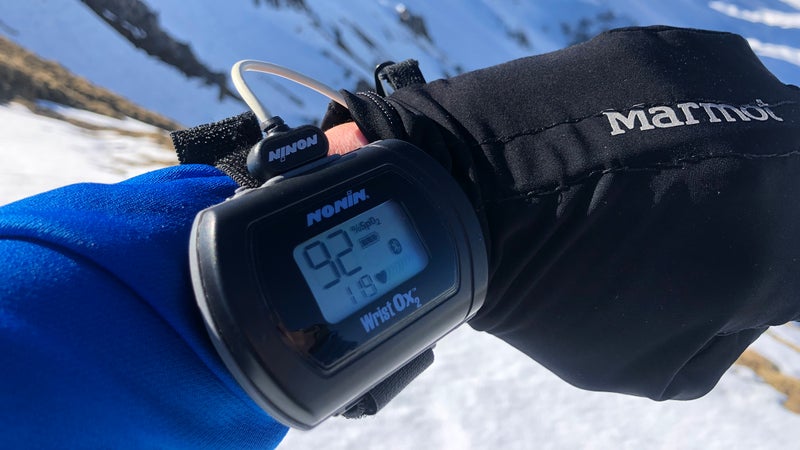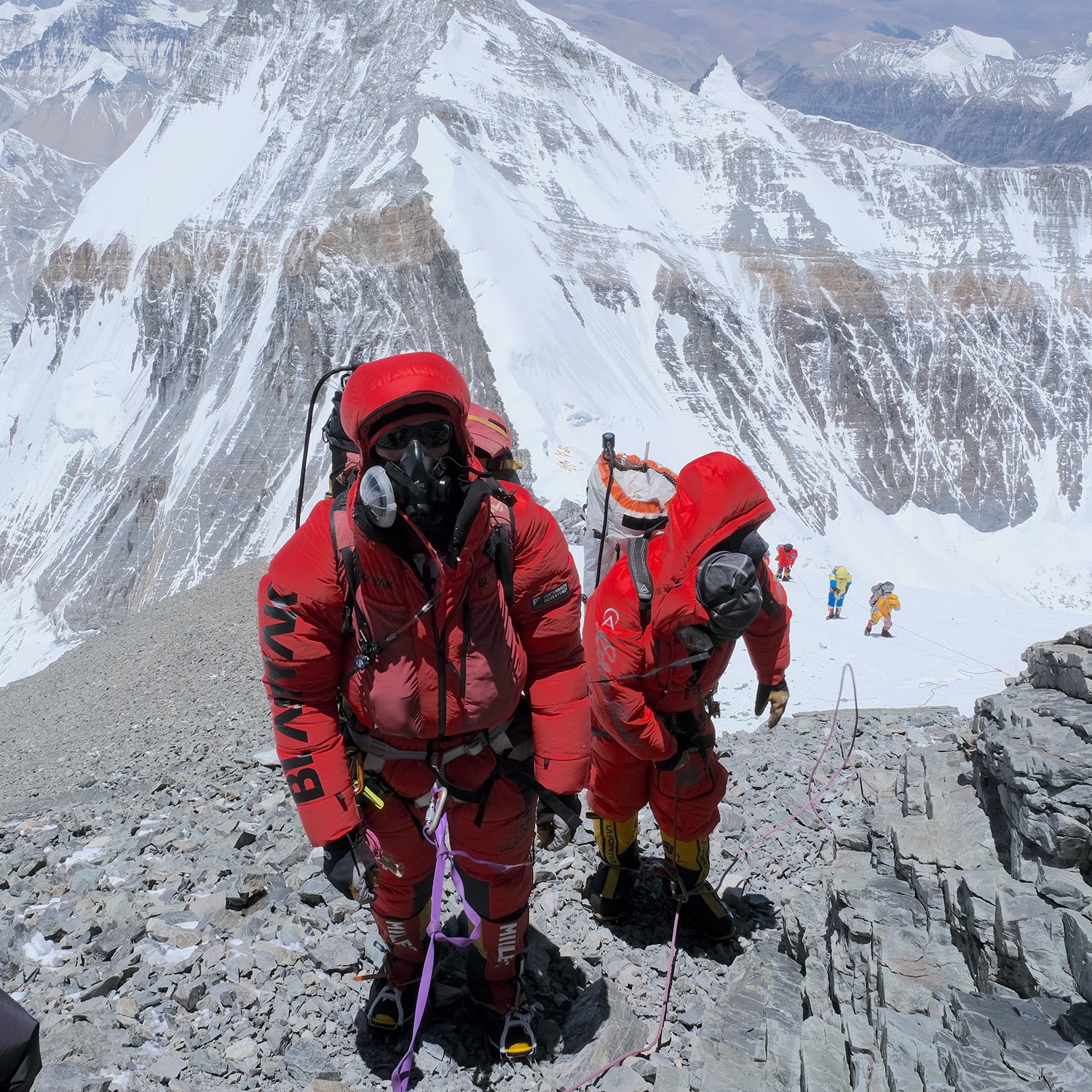Death and danger are inexorable facts of summiting Mount��Everest, but a longtime��guide thinks a new system��can��help prevent��one of the most common issues there: high-altitude pulmonary edema (HAPE).��Lukas��Furtenbach,��who has been running expeditions in the Himalayas since 2001 and founded Furtenbach �����ԹϺ���s in 2014, plans to implement��a new pulse oximeter��system on Everest during the 2021 season that, he claims, will make climbing��the world’s tallest peak as safe as flying. (The odds of dying on Everest are about , compared to��about in a plane crash.) Whether that��is��true or not remains to be seen.
Dr. Leo Montejo, an anesthesiologist and founder of the telemedicine company WiCis, created a system to track climbers’ health metrics on the move using I-Streme, an Android app he developed that sends live data via satellite back to Base Camp, and a Nonin WristOx2 3150 pulse oximeter. In 2019, Dr. Montejo brought a version of the system to Furtenbach to test with his team on Everest. They’ve since parted ways to develop different versions of the system.
Pulse oximeters measure oxygen saturation (SpO2) by calculating the percentage of the blood’s hemoglobin with oxygen attached to it. At sea level, 94 to 100 percent saturation is considered normal; at, say, 18,000 feet (just above Base Camp),��a climber’s oxygen saturation��might range from 60 to 90 percent on supplemental oxygen. Saturations below that range suggest��hypoxia and, in theory, could point to the onset of illnesses like HAPE, an accumulation of fluid in the lungs that can be deadly. Pulse oximeters aren’t new—they’re prevalent among hang-glider pilots and balloonists, and��doctors use them to monitor patients with lung disease or, lately, COVID-19. But on Everest, their use has generally been limited to Base Camp readings to gauge acclimatization. That’s partly due to a technology gap that��the new��system may be closing.
Furtenbach notes that��sensors in use today��don’t��work when climbers are active,��which is the most essential time to gauge saturation. “SpO2 is the main indicator for whether somebody’s developing altitude-related health problems, like HAPE,” he says. If guides and Sherpas��can constantly measure a climber’s oxygen-saturation��levels while they’re active, Furtenbach’s thinking goes, they��can keep a better eye on clients and use the readings as a data-based impetus to increase oxygen flow or turn back at-risk climbers before the summit. In the past, Furtenbach says, making these types of decisions “was always not based on facts, it was always a decision based on our experience—hard to understand for the client. Now we can just show the��numbers and say, ‘It would not be wise if you go on.’”
Furtenbach’s team, which operates on Everest’s north side,��tested the system last year with one of the team’s guides, three clients, and Dr. Montejo acting as expedition doctor. Climbers using the oximeter wear a sensor on a��finger inside gloves that Furtenbach adapted and a large display on their wrist outside their down suit. As with all climbers who are using supplemental oxygen, a regulator is attached to��a��backpack strap. The new system, which utilizes Summit Oxygen cylinders and mask, allows a flow rate of��up to eight liters per minute, according to Furtenbach, an increase��from the standard maximum rate of four liters per minute. With one element still in testing, wearers��sleeping in the higher camps wake to��the system’s��vibrating alarm��if oxygen-saturation��levels drop below some preset critical value (typically about 85 percent, though the number is individualized for each climber). Furtenbach says that everything worked well during these on-mountain tests.��(He has since switched to another app, still in development, which he hopes will work better at very high altitudes.)

A complementary benefit of the system could be to conserve supplemental oxygen. “Because we don’t say you climb on four liters a minute��or whatever,” Furtenbach explains. “We say you climb on the oxygen-flow rate that your body needs. And this is very individual.”
Protocol for using the oximeter is theoretically straightforward. Sherpas check clients’ oxygen-saturation��readings every ten minutes and, if necessary, adjust oxygen flow. When satellite connections allow, real-time data also streams down to Base Camp,��where��an expedition doctor��monitors and radios guides if someone’s numbers are consistently low (when the connection fails, guides radio down to base camp. In such cases, a climber’s Sherpa will increase the oxygen-flow rate by half a liter per minute, as many as three times. If there’s no improvement, they’d likely decide to turn a client back.��
This��method, however, strikes some as problematic. “To make a decision about the safety of a climber based solely on a number appearing on display on the outside of a glove at��minus 30 degrees��Celsius seems to me to be closer to reckless than safe,” says��Monica Piris, an expedition doctor for Alpenglow Expeditions, a rival guiding company.��“Similarly, titrating someone’s oxygen flow based on this number also seems crazy. People who are using supplementary oxygen to climb Everest should be using as much oxygen as they possibly can.”
Dr. Piris considers pulse oximeters fickle devices in the best mountaineering circumstances. Readings bounce around constantly from motion, which blurs readings, or from poor circulation in cold fingers.��Below 80 percent saturation, levels in which Everest climbers typically live, readings��become less accurate. (At this point, the data is no longer based on comparisons to actual blood samples done in labs, and pulse-oximeter companies aren’t required by the FDA to report data below 70 percent saturation.)��The new sensor, made��by Nonin and designed especially for active measurement, works “perfectly”��while climbing in the cold, Furtenbach��says.��
Yet even if oxygen-saturation��numbers are accurate, the spectrum of well-being that oxygen saturation indicates varies so widely between individuals that it’s��impossible to create a one-size-fits-all protocol. The main crevasse for Furtenbach’s team to hurdle is that there’s still no consensus for normal oxygenation ranges on Everest. Because pulse oximeters have never been used while summiting, Dr. Piris notes that “we have no idea if it’s normal to summit with saturations in the fifties, in the seventies, or in the forties.”
The new system still bears promise. “It’s potentially great,” says Peter Hackett, a pioneer in altitude research and director of the Institute for Altitude Medicine, who has also summited Everest. “There’s no question in my mind that it makes the climb safer, because they can diagnose pulmonary edema more quickly. That’s the main reason. In cases of HAPE, SpO2 will always be very low.”��
A lot goes into an oxygen-saturation��reading, and while useful, the��data��can be deceptive. If a climber takes a few big breaths at 18,000 feet elevation, Dr.��Hackett says, their reading��might jump from 70 to 80. During active climbing, oxygen saturation drops, because red blood cells go through the lungs more quickly when you exercise. There isn’t enough time for them to equalize with the oxygen in your lungs. Any pulse oximeter measures the amount of oxygen at your fingertip in a given moment, oxygen that was in your lungs about 30 seconds earlier. The lag time makes it tricky for guides to interpret the number, depending on whether they’re looking for oxygenation while you’re active or at rest. (It would likely be difficult, given the terrain, for a guide to reach a client in time to observe active oxygenation.) And some people are just shallow��breathers at high altitude, so their numbers will always be lower. It doesn’t mean they’ll have problems.
“To make a decision about the safety of a climber based solely on a number appearing on display on the outside of a glove at��minus 30 degrees��Celsius seems to me to be closer to reckless than safe,” says Dr. Monica Piris.
These complexities may turn thorny when guides and clients become too reliant on oxygen saturation��to direct their actions. “If a climber wants to show their��guide that their number is high,” Dr.��Hackett notes, “all they��have��to do is take three or four big breaths.”��
Two-time Everest summiter��Kuntal Joisher, who is based in Mumbai, India, and who watched Furtenbach testing the new pulse oximeter at��the north-side Base Camp last year, feels that such a device would only complicate his climb. Joisher says he would have to��take oxygen-saturation numbers into account contextually but would never change oxygen flow based on that alone.��
“If I’m very near the summit,” Joisher says, “my decision would be very different than if I’m very far from the summit. That device does not know where I am. Knowing Lukas, I’m sure he’s going to be really rigorous and diligent about using the oximeter. But you still need to know what you’re doing as a guide, as a Sherpa. You need to understand how to look at a client, how to talk to a client, and how to understand where the client is.”��
“Look at it as a research project, because we just don’t know,” Dr.��Hackett says.��“At this point, it definitely has to be considered experimental. I would consider using them to make on-mountain decisions��a bit dicey.”
Like Dr. Hackett, Joisher believes oxygen saturation is best used in tandem with��other symptoms: headache, nausea, fatigue, loss of mental acuity. “Let’s say you look at a client and think, Man, this guy’s knackered, he’s not acclimatizing,”��Joisher says. “Then you look at the reading and see the oxygen saturation is 55. So you know, OK, what I’m thinking is actually true, let’s ask this guy to turn around. Instead of saying, ‘Hey let’s look at the reading. It’s 55. You need to go down,’��maybe it’s just a malfunction. Maybe they’re��just tired, and if they rest��a bit, they’ll improve.”
“The SpO2 and HR [heart-rate]��readings would be just one part of the decision-making process,” Furtenbach says of his team’s plan for the system. “But a very substantial one, since biometrics don’t lie, and the devices don’t��have��emotions, summit fever, or other motives.”
In the meantime, Dr. Hackett’s��advice to Furtenbach��is: collect data, get some experience, and empirically try to determine the oxygen levels at which climbers perform well. “Look at it as a research project, because we just don’t know,” Dr. Hackett says. “At this point, it definitely has to be considered experimental. I would consider using them to make on-mountain decisions��a bit dicey.”
Furtenbach thinks the pulse ox system is ready for climbers, though his team is using the lack of a 2020 Everest season to field-test other sensor additions to monitor metrics like heart rate and hydration levels. “Everybody will be using this on our team next season,” he says, although he agrees that more use and data will help perfect the system. “We would like some more experience with clients, because not many people have used it so far.” Furtenbach would��like to have at least one full season using the pulse oximeter with a dozen��to two dozen��climbers before making another round of tweaks, which he suspects would enable Furtenbach �����ԹϺ���s to offer the system as a whole package, including software and hardware, for other teams to use in future seasons.
Joisher thinks the new system might��prove��most helpful to Sherpas who don’t know their clients’ abilities well on commercial expeditions like Furtenbach’s. It would give them another piece of information for smart decision-making. As for himself, he prefers the hard-won data of pure experience. “Having that good trust, having that good partnership, that’s the style I like,” Joisher��says.��“I don’t like depending on technology so much. I don’t see this as being a game changer.”��
Other guiding companies may consider incorporating the system into their protocol if it becomes available in 2022 or beyond. “Overall, I think more data is better than less,” Adrian Ballinger, founder of Alpenglow Expeditions and a friendly rival to Furtenbach, concedes. “So if it’s possible to get accurate pulse-oximeter information on a real-time basis, that sounds great. But I’m not sure it would significantly change my decision-making. Climbing Everest with a fully certified guide company that runs the mountain in an ethical way, with small groups and low client-guide��ratios, is incredibly safe as it is.”


